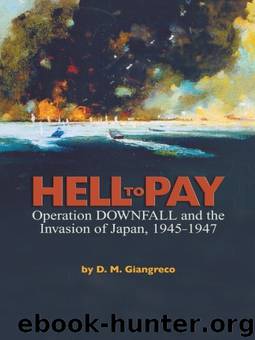Hell to Pay: Operation DOWNFALL and the Invasion of Japan, 1945-1947 by Giangreco Giangreco

Author:Giangreco, Giangreco [Giangreco, Giangreco]
Language: eng
Format: epub
Publisher: Naval Institute Press
Published: 2011-04-01T04:00:00+00:00
The Second General Army’s decision to allow its formations considerable flexibility in the conduct of the defense may not have been seen as much of a compromise by those advocating strict adherence to the offensive precepts of Ketsu-Go. This having been said, however, it must be noted that Hata pressed repeatedly, if unsuccessfully, for any divisions he could get from the reserve at Kanto, 32 but the Japanese leadership was just as loath as MacArthur’s headquarters to allow the fighting in Kyushu to siphon men and material away from what both sides believed would likely be the climactic battles around Tokyo. Once battle was joined, the U.S. Sixth Army and Imperial Sixteenth Area Army would quickly become orphans, left to fight it out largely with the units already on hand. And this would only change if higher headquarters in either Manila or Hiroshima perceived that the U.S. complex of staging areas in the south, or alternately, the island’s rich resources in the north, were at risk.
One significant by-product of the Japanese decision to stick doggedly to the regional priorities of Ketsu-Go as well as their decentralized command and mobilization schemes (see chapter 7) was that they rendered the U.S. strategic, and even operational, deception plans for Olympic largely irrelevant. 33 Code named Pastel, they were patterned after the very successful Bodyguard operations conducted against the Nazis before, and even well after, the Normandy invasion. Through a series of ruses, disinformation, and feints, very substantial German forces were held in check far from France, in Norway and the Balkans, and a wellequipped army north of the invasion area was kept out of the fight until it was too late to intervene effectively. 34
Deceptions of this type proved to be particularly useful in Europe, with its extensive road and rail nets, but were ineffective against the Japanese at this point in the war. Pastel’s planners assumed a strategic mobility that the Japanese no longer possessed for higher formations—divisions and the corps-sized Imperial armies—and were made even less effective by the U.S. air campaign against the Home Islands, which would have essentially frozen those formations into place. Distant movements could only be conducted division by division, in a dispersed manner, and only at a pace that a soldier’s own feet could carry him. 35 The Japanese themselves had realized that this would occur and successfully completed major troop movements to Kyushu early in the year (see chapter 3). Moreover, their system of defense call-up and training during 1945 was reoriented toward raising, training, and fielding combat divisions regionally in order to minimize lengthy overland movements. 36 With major population centers on Kyushu and elsewhere within easy marching distance of threatened areas, Imperial forces could actually achieve a high degree of success in this effort.
Interestingly, the effectiveness of the U.S. naval blockade also rendered the Pastel deception operations targeting Formosa and the Shanghai area unnecessary as Japanese shipping could no longer transit the East China Sea to reinforce the Home Islands. In addition the extensive American efforts to play on Japanese fear of airborne operations also were of no avail.
Download
This site does not store any files on its server. We only index and link to content provided by other sites. Please contact the content providers to delete copyright contents if any and email us, we'll remove relevant links or contents immediately.
| Africa | Americas |
| Arctic & Antarctica | Asia |
| Australia & Oceania | Europe |
| Middle East | Russia |
| United States | World |
| Ancient Civilizations | Military |
| Historical Study & Educational Resources |
The Radium Girls by Kate Moore(11886)
100 Deadly Skills by Clint Emerson(4815)
Rise and Kill First by Ronen Bergman(4669)
The Templars by Dan Jones(4610)
The Doomsday Machine by Daniel Ellsberg(4386)
The Rape of Nanking by Iris Chang(4116)
Killing England by Bill O'Reilly(3936)
Hitler in Los Angeles by Steven J. Ross(3879)
Stalin by Stephen Kotkin(3840)
12 Strong by Doug Stanton(3469)
Hitler's Monsters by Eric Kurlander(3251)
Blood and Sand by Alex Von Tunzelmann(3112)
Darkest Hour by Anthony McCarten(3052)
The Code Book by Simon Singh(3044)
The Art of War Visualized by Jessica Hagy(2907)
Hitler's Flying Saucers: A Guide to German Flying Discs of the Second World War by Stevens Henry(2679)
Babylon's Ark by Lawrence Anthony(2512)
The Second World Wars by Victor Davis Hanson(2461)
Tobruk by Peter Fitzsimons(2425)
